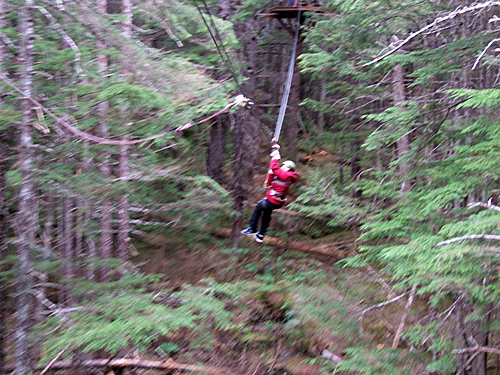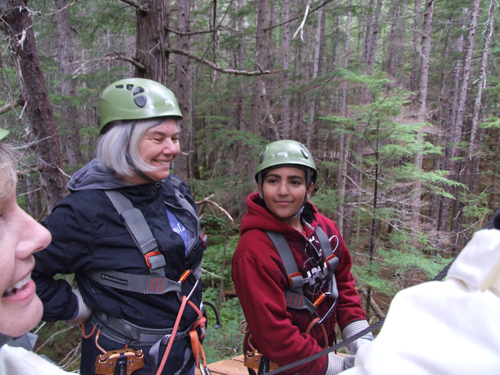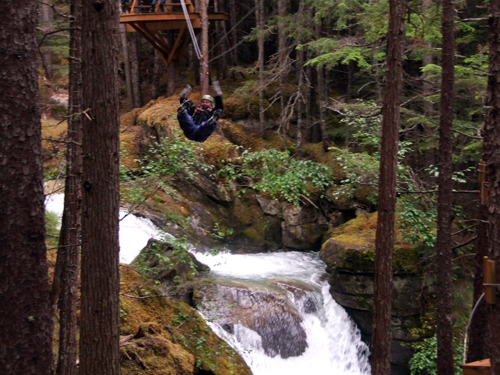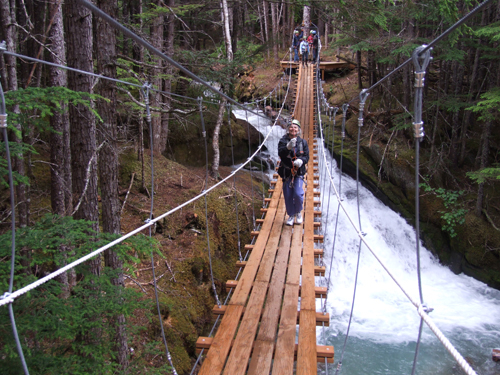
By Donald H. Harrison
DYEA, Alaska – It was the first time for any of us, and grandson Shor’s apprehension grew considerably as the unimog—described cheerfully as a “jeep on steroids”—climbed a logging road to where our Alaska Excursions Mammoth Waterfalls and Ultra Zipline Adventure would begin here in the northern outskirts of Skagway.
Nancy and I did our best to cheer him up as the vehicle bounced up the mountain, but he just grew quieter and quieter, tenser and tenser, as Todd, the driver up in front, chatted on about history, scenery and other subjects that simply couldn’t divert the attention of our 10-year-old from whatever doom he foresaw for himself.
Given that neither Nancy nor I had ever zip-lined before either, I can imagine that our assurances were not all that persuasive. Perhaps, he sensed that we were camouflaging our own doubts and fears about the upcoming adventure. Kids have a way of knowing when the adults in their life are faking.
When we got to the base camp, we were met by a pair of professional guides, Stache and Christian, who would be our instructors over the 11-line course. Christian, that’s a wonderful name, but is this any place for a nice Jewish boy and his grandparents?
Something in Stache’s and Christian’s cheerful demeanor, the way they were clearly looking forward to another adventure, began to ease Shor’s apprehensions – and ours. They had been over the course countless times. As they buckled us into our harnessses and made sure we donned heavy gloves and helmets, carefully checking and rechecking our equipment, Shor’s mood switched from one of dread to hesitant interest.
Now came what, for amateurs like ourselves, may have been the most important part of the course: a low introductory “bunny” line over a small stream. If we fell, we might get wet, possibly sprain something, but clearly it wouldn’t be fatal.
We climbed a platform, watched some other adventurers go first, heard their shouts of delight, and decided that the best way for us to assure Shor would be for one of his grandparents to go first, let him go next, and for the other grandparent to go after him. In that manner, we reasoned, there would always be a grandparent on the platform to reassure him.

Shouldering my responsibility, I was the first of our family to go. It didn’t take very long at all, and I was standing on the platform across the stream. No worse for the wear.
“Wow!” said Shor, as he completed his test zip, “that was awesome!”
When Nancy came zipping across, she giggled like a teenager.
So we decided, notwithstanding my lingering doubts, that we were ready to do this. The next zip line was a bit longer, a bit higher. Those who laid out the course wanted to increase the sense of challenge from platform to platform. Lines typically were 50 feet above ground, and ranged in length from 60 feet to 750 feet. They had such nicknames as “The Running Man” because you start off running; “The Big Kahuna” which is quite a bit higher than 50 feet; and “The Pipeline,” which is the one 750 feet long.
We soon learned the routine. One guide would go first to the next platform and there set up to receive us. If he felt we were coming in too fast, he would signal for us to pat the zipline behind our trolley hookup. That would cause us to slow a little. If we still came in too fast, the guide knew how to physically slow our movements and maneuver us to safety on the platform. After each of the clients made the crossing, the other guide – who had launched us from the previous platform — would follow. The guides alternated responsibilities, and while making the platform-to-platform crossings demonstrated for us some of their zip-line stylings.
One got his legs into a lotus position and kept them that way until he reached the other platform. One did a backwards summersault off the platform. At each line, it seemed as if we were being treated to another pose or acrobatic stunt. “Have fun” was the clear message they were communicating to us.
Once I felt reasonably confident that the zip-line wouldn’t snap under my weight (265 pounds is the limit for this particular course, giving me a 10 percent margin), I began to breathe easier, and even to take the time to admire the scenery of the Tongass National Forest as we awaited our turns on the platforms.
Sitka Spruce and Western Hemlock are the dominant trees in the temperate rain forest of Alaska. “Hemlock,” I thought distractedly, “wasn’t that the way they poisoned Socrates?” I looked down from the platform to the forest floor. “They could have just put him up here and given him a little push.”

In fact, however, one can’t fall far from the platform because the same lanyard that connects your harness to the zip-line cable can also be connected to steel rings on the platform. The lanyard is long enough for you to walk comfortably around the platform but too short for you to stray too far from the center pole. You are not unhooked from those rings until it is time for your caribiner to be fastened to the zip-line cable itself.

Besides forest scenery, there were streams and waterfalls, and potential plunges of what seemed like hundreds of feet as the course became more dramatic. Shor and Nancy clearly were thrilled by it all; I a little less so. Although I was under the weight limit, I was the heaviest of the zip-liners present, and it seemed to me that all that extra avoir-dupois was causing me to zing along the zip line faster than anyone else. So I had a tendency to hold on tight to the lanyard.
In other words, I tensed for each ride, whereas the guides—and to a lesser extent, Nancy and Shor—were able to relax and enjoy the ride.
Shor was a study in transformation. From tense, reluctant and scared, he became successively emboldened. No more of this being sandwiched by grandma and grandpa; once the guide reached the other platform, Shor was delighted to be the first of the visitors to go. “I can fly,” he exclaimed at one point, stretching his arms out like an eagle as he zipped from one side to another.
Nancy also got into the spirit of things, accomplishing on one particular drop the “leap of faith” whereupon she simply put out her arms and fell forward from the platform, as if she intended to belly flop into a swimming pool. I don’t think I have ever heard her laugh with such delight in our 43 years of marriage.
One of the zip-lines crossed a 750-foot span, which our guides pointed out is 2½ times the length of a football field. On this line, we were traveling through the air for at least 30 seconds — about 25 feet per second– between platforms. I wouldn’t have been surprised if some eagle flew up from one of those branches to check us out, as bald eagles are quite common in this area.

In addition to the zip-lines, the course also includes suspension bridges, which adventurers walked over while hooked to the safety of the cable above. This is very different sensation than zip-lining, and also has the advantage of you being in sufficient control of your movement to be able to jump up and down or even to take photos while crossing.
As our adventure neared its conclusion, the guides suggested that as we zipped across the next chasm that we shout out our favorite movie lines.
“Scre-ee-ch!” yelled Shor in imitation of a character in some movie about eagles.
“The Yankees are coming, Miss Scarlet” yelled Nancy, an ironic reference up there to Gone With The Wind!
“I’m mad as hell and I’m not going to take it anymore!” I called, imagining the sound of my voice echoing through the Alaskan rain forest.
Of course, what I yelled wasn’t true. I wasn’t mad, I was delighted. And as far as zip-lining again, what’s this I hear about a zip-line attraction at the Wild Animal Park back home in San Diego?
*
Some particulars: Zip tickets cost $169 for adults, $149 for children under 13. Plan to be away from Skagway between 4 and 4 1/2 hours. Additional information via website www.alaskaexcursions.com
*
Harrison is editor of San Diego Jewish World. He may be contacted at donald.harrison@sdjewishworld.com
File: US Canada West 18